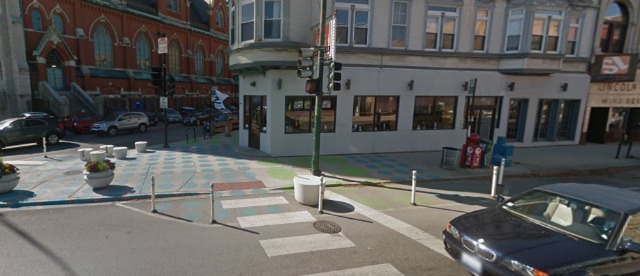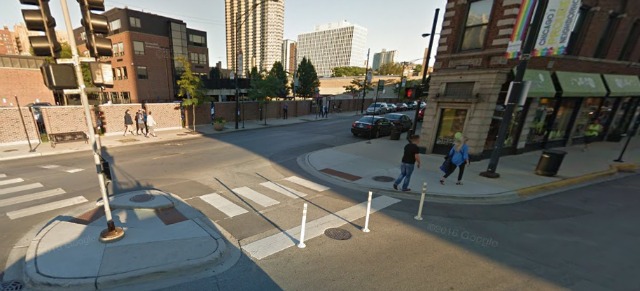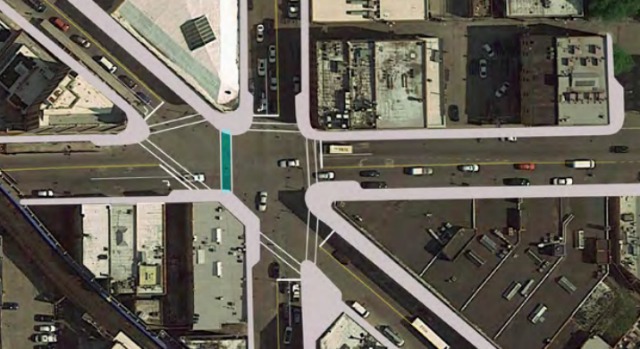How The City Plans To Make Wicker Park's Dangerous '6 Corners' Safer
By Stephen Gossett in News on May 10, 2017 2:30PM
To bike or walk through the bustling intersection of North, Milwaukee and Damen avenues is to know that something’s gotta give, in terms of infrastructure. Quite frankly, it could use a major overhaul. But while the intersection’s unforgiving engineering keeps long-term fixes out of focus for the time being, local officials and the Chicago Department of Transportation aren’t waiting around to get moving on much-needed short-term amelioration.
Taking cues from a plan of recommendations released by the Wicker Park Bucktown Special Service Area #33 back in February, CDOT—joined by Ald. Brian Hopkins, Proco Joe Moreno and Scott Waguespack (those six corners bump several wards)—floated on Tuesday a handful of intriguing “low-cost, quick-hit” pilot projects to improve safety and better tailor the street environment to how people are actually getting around.
Here are some of the possibilities put forth to residents at the community-input meeting:
Paint/Post Curb Outs
These curb extensions could be added strategically along the perimeter of the intersection. The aim is to reduce crossing distances for pedestrians, increase visibility and also help reduced motorist speed. You can see the concept in the image below, at the Lincoln Hub (Southport, Lincoln and Wellington), which was invoked in terms of similar examples. Don’t worry; Mike Amsden, Assistant Director of Transportation Planning at CDOT, promised no polka dots in Wicker Park.

Paint/post curb outs at Lincoln Hub / Google Maps / Screenshot
Slip Lane Closure
There’s a pretty huge use disparity when it comes to that little standalone island situated at the southwest corner of Damen and Milwaukee. More than 1000 thousand people walk along the slip lane during combined morning and evening peak hours; but just 32 drivers pass through during that same timeframe, according to CDOT. A ped-friendly plaza-like closure would function much like the one at Broadway and Halsted (pictured below, after the Wicker Park slip lane).

Slip lane closure in place at Halsted and Broadway / Google Maps
Crosswalks Where There Are None
Ever catch somebody doing the frogger shortcut walk from near Starbucks all the way across to the Walgreens? You’ve probably done it, we’ve done it, and, according to CDOT, a lot of people do it. The intersection’s high sidewalks could make it difficult to transform residents’ favorite impromptu crosswalk into an IRL crosswalk; and as Amsden cautioned, “Just because it makes sense doesn’t mean it’s a guarantee.” But we’re happy to see it at least on the table.

Right there where that neon green strip is / WPB SSA #33
Get Rid of Turn Lanes
Drivers would still be allowed to make left turns, where they’re not already restricted—but dedicated lanes could be made un-dedicated, freeing up much needed space. While the driving rate remains flat citywide, more than 800 cyclists pass through the busy Wicker Park Six Corners intersection during morning peak hours, and there are thousands of pedestrian crossings each day during AM and PM peaks, according to CDOT.
Reduce Speed Limit to 20 Miles Per Hour
Speed limits as posted near the intersection range between 25 and 30 mph. But the vast majority of drivers are already going 24 mph or slower around the crux, CDOT said. Making a slight reduction official could help boost safety.
Other options include green-pavement bike boxes and bike lanes; and the plan is also considering infrastructure changes on Milwaukee from Armitage through Division.
For the moment, the project remains in the data-collection and public-input phases, and details appear to still need ironing. (For instance, one attendee worried that a slip closure might negatively impact cyclists; and CDOT needs to look closer at, for instance, if turn-lane elimination could impact side-street traffic.)
But appetite for some change at the intersection is palpable. Slip-lane closures and curb-outs appealed to Janelle Campos, a Wicker Park resident and frequent cyclist. “Anything that improves the speed differential so it’s not as drastic,” she said. “If cars are forced to slow down from a bump out, it gives people a better chance to see them.”
The next community meeting is scheduled for July 17. However it unfolds, some form of action is imminent. Some $150,000 is already allocated for restriping later this year, and even given how much volume from outside the neighborhood traffics through the intersection, Hopkins said he’s willing to reach beyond the wards for any additional financing that might be necessary. The cost “shouldn’t fall exclusively on us,” he said. The TBD construction is slated to commence in August.


A map of the intersection with wish-list scribbles from community members / Photo: Stephen Gossett
